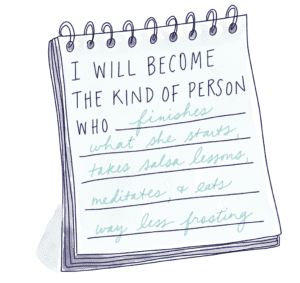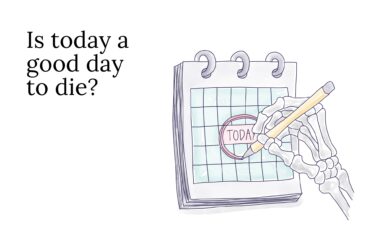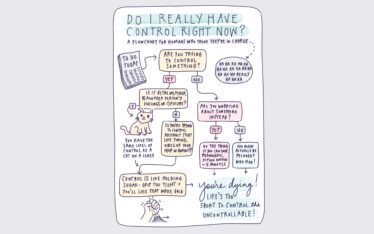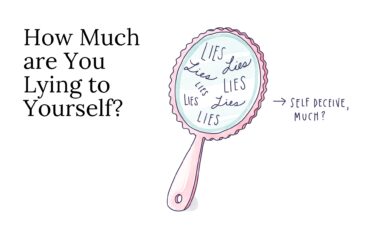Imagine for a moment You, but Better — you know, that ideal version of yourself? Or versions, plural?
You might be that person already (good for you! Although I’m immediately suspicious of you for all sorts of reasons), but chances are you’re striving to become a New and Improved You in at least one facet of your life. You likely have ideas and goals and fantasies about who you could be, and just as likely a (possibly deep and foreboding) sense of who you’d rather not be, thank you very much.
Psychologists have studied this concept of possible selves for decades — how we fathom our futures, imagine who we might become, and pine after our potential. Random examples of my clients’ possible selves include:
- “I could go back to school to become a graphic artist, and then I’d get to be creatively fulfilled (and wear cool boots)”
- “I see myself becoming the healthy type who runs 10k with ease (and then eats smoked salmon at brunch)”
- “I imagine starting my own consulting company (and getting those really thick business cards)”
- “I could be a Dad to foster kids (and further build my repertoire of dad jokes)”
- Etc., etc., etc. ∞
Most of us have numerous possible selves conjured up, ranging on the Possibility Scale from Totally Possible, You Go Girl! to Downright Impossible, You’re a Delusional Ass. All of this is fine, though. We’re allowed to fantasize about the version of ourselves who wins the Olympic decathlon gold medal (even if we don’t even know what ten events even go into the decathlon), because most of us have a delusions of grandeur sensor in our heads that discerns quite nicely the difference between what’s never going to be possible and what’s possible if we could only get out of our own way.
The good news is we’re fully mutable.
We can change and improve ourselves (and I mean beyond Coolsculpting), in minor ways all the way up to full-on magnanimous metamorphizations (within reason, you wannabe decathletes).
We can become the version of ourselves who flosses daily and reads biographies. We can become the gender we wish we were born into, we can leave exceptionally underwhelming jobs, we can go to rehab to kick whatever addictions plague us. We can move to Paris. We can join the circus. Maybe go vegan? How you want to enhance your life is up to you, and there is no right or wrong about what that looks like (although fair warning: you will be judged if you join the circus). The important thing is to believe that you are changeable.
Researchers have found that contemplating better versions of ourselves can foster optimism in our ability to change. Imagining the person you want to be can provide the motivational fuel for the vision. “I could see myself becoming a CMO one day” — an example of a seedling of an idea — has the potential to spark action (like taking digital marketing courses in the evenings, working with your manager on a development/ promotion plan, getting a big cheese marketing mentor, etc.). We can shift our hypothetical possible selves to living, breathing, “I made this happen” kinds of realities. Imagining possible selves can help us break free from the stuckness that so firmly plants us in place beyond our expiry dates in jobs and relationships that no longer serve us.
But what happens when our possible selves don’t pan out?
Right, that.
Pulling the plug on who you wanted to be isn’t always easy, is it? Like any goal we shoot for, we often attach ourselves to its outcome and find it hard to be with ourselves when we miss the mark. (We’ll talk some other time over a hot drink about how many of us thwart the goal-setting process from the get-go, just to avoid the bitter taste of disappointment if things don’t turn out the way we envisioned. Oh, the distaste we have for failure!)
One of my clients longed to make the 40 Under 40 list in her city’s most prominent business publication. On her fiftieth birthday she found herself definitely over forty and definitely not on the list. She mourned the death of that possible self.
Another client saw himself as a marathoner — fancied himself as the sort who’d put the medal on display in his home office and regale his kids with stories of overcoming the odds and maintaining an attitude of stick-with-it-ness. One small problem: he hobbled off the course at mile 19, physically unable to finish the race. He grieved the loss of this possible self (and the loss of a lot of knee cartilage).
Some possible selves are easier to abandon than others. A woman I coached last year worked long and hard to become a lawyer, then worked longer and harder to become a partner in her firm. But the sizzle fizzled and the life she so intricately envisioned for herself just wasn’t compelling anymore. She wanted to try on other possible selves for size. She was willing to refresh the identity she’d created for herself as “successful litigator who mentors newbies at the firm and also wears great glasses,” so she went to work at a not-for-profit (still wearing cool frames).
It’s a little obvious to connect the dots between lost possible selves and regrets; when a goal or dream gets flushed down the toilet, we can understandably lament what was supposed to happen, who we were supposed to become. Encouragingly though, researchers point out that lost possible selves can lead to a development of maturity and a deeper understanding about our view of the world. “Unmet expectations may be a key to development” is what King & Hicks have to say about that profound point.
As we’ve discussed before, meaning is often forged through hardship. Effortlessly realizing every version of our best possible selves doesn’t do much for manufacturing meaning in our lives. Not becoming the VP of Finance you imagined for yourself… not making the US soccer team as you so vividly intended… not becoming the parent you always thought you’d be… not seeing your possible selves transpire at the snap of a finger adds layers of depth to your life, like the umami of the flavor world: rich and nuanced (and oh so wonderfully parmesany).
The client I told you about above who aged out of the 40 Under 40 profile? She recalibrated her need for recognition and is finding satisfaction pursuing a new version of herself as “the kind of person who is confident without (as much) external validation.” (For jokes we made a Forbes magazine cover with her face on it, to satisfy her fame fix.)
The client who limped off the marathon had his race bib framed; he now tells his kids about the importance of trying hard and knowing when to surrender (i.e.: when your knee is giving you stop sign signals at mile 12, not when it’s in agony at mile 19). He wants to be the kind of person who gracefully recovers from a setback. I think he’s there.
So what’s possible with our possible selves?
 Psychologists have made it clear that going after goals that matter is good for our well-being, and that getting super clear about our “best possible selves” ultimately boosts our subjective life satisfaction.
Psychologists have made it clear that going after goals that matter is good for our well-being, and that getting super clear about our “best possible selves” ultimately boosts our subjective life satisfaction.
Falling short of these versions of ourselves builds the muscles of meaning, while becoming these versions of ourselves proves we can grow and change and become even better than we are today.
Indulge your conceptions of possibility. What’s on your list of possible selves? Make a list of all the envisioned futures you have for yourself, both tiny and tremendous. You’re great today, and in the interest of self-actualization (yes — the top of the pyramid!), never stop trying to get to know the New and Improved You. That person is pretty freaking fabulous.
9 of my own personal possible selves (out of 950+):
- I‘m going to become the kind of person who is less afraid to “put herself out there” for the world to judge. (Insert the sound of a person taking a deep breath in right here. I’d type it but you’d just get confused: “Ffffffffffttt.” See?)
- I could evolve into the kind of person who says, “perfect is the enemy of good” and doesn’t feel a) like a liar, and b) like I might drown in the disappointment of how it could have been if I didn’t settle.
- Oh and my posture! I’m going to become the person who once and for all stands with her shoulders back, as though she had toned upper back muscles. (So, I’m going to become the kind of person who tones her upper back muscles.)
- I‘m going to become the kind of person who stays in better touch with the friends and family I all too easily lose touch with, not because I don’t care but because I do this silly thing where I get busy and don’t reach out for a while and then because so much time has passed I feel terrible and instead of reaching out to make it better I just make it worse by not reaching out at all.
- I see myself becoming the kind of person who gets in touch with her spiritual side (without having a crisis be the thing that makes me sheepishly say, “Yo, G, you still upstairs? Can I get some help down here please? I know it’s been a minute.”)
- I’m going to become the kind of person who washes her sheets more often.
- I envision giving money away to cats and birds when I die (which will require the hassle of changing my will, but organizations that support fur and feathers are worth it, right?).
- I’m going to be the kind of senior who is so vibrantly alive that young people marvel at my vitality (which I know means they will humor me by saying things like, “You don’t seem 75 at all, Jodi! More like 70!”).
- One day I will become the kind of person who writes with less words. Just not this time.







